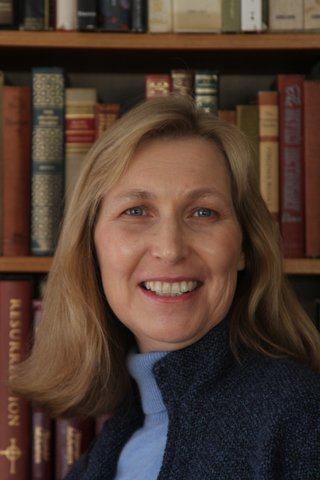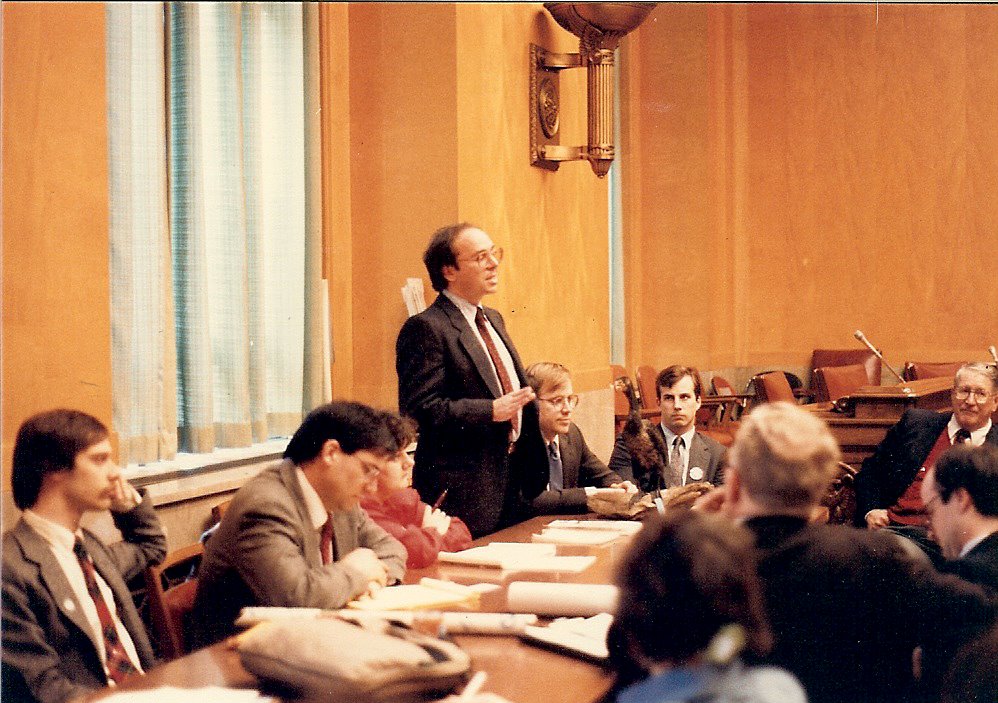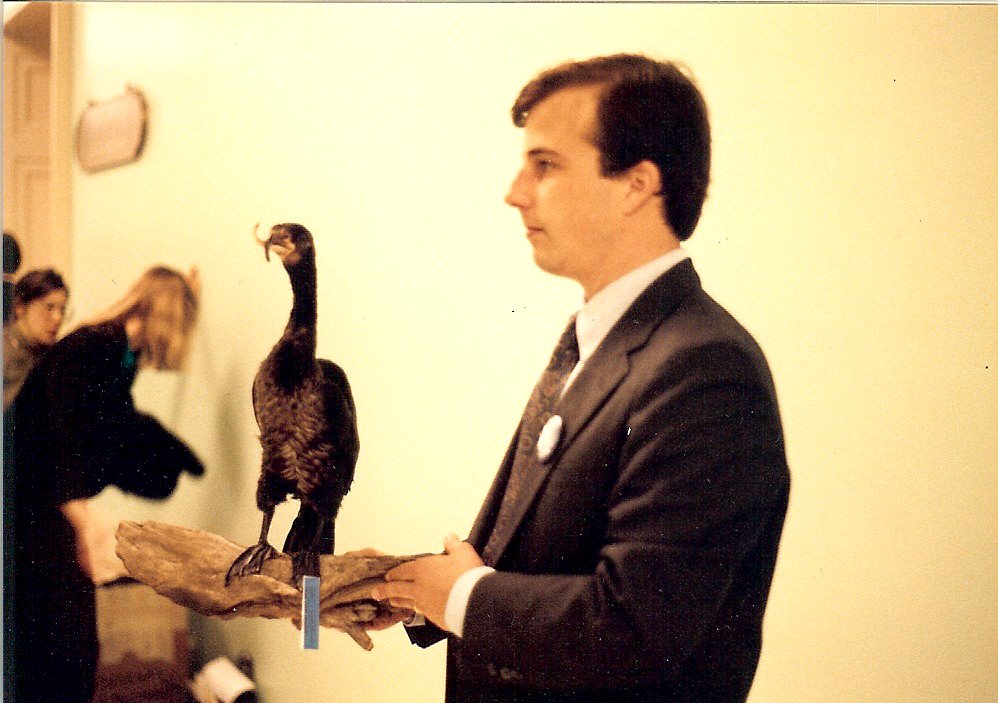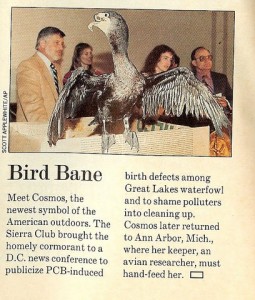
Jane Eder
Commentary
By Jane Elder
On June 30th, the Great Lakes landscape changed.
Not the physical system, but the organizational landscape that has been part of the Great Lakes citizens’ movement for three decades. With only a few days of public notice, Great Lakes United–the only binational coalition organized around Great Lakes environmental protection–closed its doors and turned off the lights.
It was a sad day for the Great Lakes.
Thirty years ago organizations in the Great Lakes region came together, realizing that issues that spanned the region and transcended national boundaries could be better addressed through coalescing the capacity of multiple organizations with varied missions that shared a common concern for the Great Lakes. They were building on regional momentum rising from the work of the International Joint Commission, whose advisory boards on science and water quality were authoritatively revealing the widespread, scary effects of toxic pollutants on Great Lakes fish and wildlife, the scale of solutions needed to address the nutrient pollution that had choked Lake Erie and much more.
The initial push for a new citizen’s alliance came from groups such as Michigan United Conservation Clubs and New York’s Save the River, brought together in part by common concerns about winter navigation on the connecting rivers of the Great Lakes-St. Lawrence watershed. But winter navigation just scratched the surface of a growing list of worries about the lakes. Those that participated in the early organizing meetings were concerned about PCBs and other pollution contaminating the food web, toxic hot spots like Love Canal, periodic threats to divert or pipe Great Lakes water elsewhere and a very long list of other issues.

Great Lakes United member John Jackson, standing, testifies at a Congressional briefing on bioaccumulative toxic compounds in the Great Lakes in 1988. Also in picture are Kai Millyard, far left, of Ontario’s Pollution Probe, and Tim Eder, to the right Jackson, who was GLU’s field coordinator then. Eder is now executie director of the Great Lakes Commission.
A motley crew
Love for the Great Lakes makes strange bedfellows, and some of the most unexpected allies included uber-sportsman Tom Washington of Michigan United Conservation Clubs, and Save the River’s Barry Freed, who was actually Abbie Hoffman working under an assumed name. Add into the mix the United Auto Workers and the regional offices of national organizations such as the Sierra Club, National Audubon Society and National Wildlife Federation. Include also numerous state, provincial and local conservation and environmental groups from duck hunters to national lakeshore advocates, as well as scientific associations, tribes and first nations.
After a “test the waters meeting” at Mackinac Island, these and other players struggled through an embattled organizing meeting in Windsor. It was rife with intrigue, factions and a threatened walk-out by Abbie. These passions were largely aroused by firm, but divergent beliefs about what we thought would make the alliance effective. We were all quite desperate for this coalition to be effective; we just didn’t all share the same notions about organizing, sharing power and engaging allies. Yet in spite of the organizational fireworks, or perhaps because of them, a diverse, complicated coalition emerged. With little debate about the name, Great Lakes United was born.
I was heading up the Sierra Club’s emerging Great Lakes program in those days, and as Great Lakes United grew, we became solid allies. We launched Great Lakes Washington Weeks in 1986. Our organizations brought leaders from throughout the basin to meet with EPA and other federal agencies, the State Department and to testify before Congress and meet with members of Congress.
A toxic buffet for Congress
Among our most audacious events was the famed “toxic buffet” where we hosted a Capitol Hill

GLU Executive Director David Miller holding the taxidermied cormorant (Henrietta) with a crossed bill during Great Lakes Washington Week 1988.
reception with 100 percent of the food and drink catered in from the Great Lakes, including the drinking water (labeled by source lake) and beautifully prepared Great Lakes salmon, lake trout and sturgeon – all lovingly presented with the official fish advisories warning about the toxic contaminants likely to be in their flesh. We figured if thousands of people eat these fish back home in the districts, why not let them be savored by those on the Hill?
Great Lakes United — which quickly became known as GLU – also helped us bring in Cosmo, the living but tragically deformed cormorant, who made a spectacle of herself sunning her wings in the television lights while scientists testified about the impact PCBs have on fetal development in fish-eating birds.
For me, those were some of the glory days for Great Lakes United. As a community of leaders and constituents, we helped strengthen the Great Lakes policy in the U.S. Clean Water Act and the Clean Air Act. We secured funding in the U.S. and Canada for research and monitoring programs and GLU played a major role in advancing provisions within the United States-Canada Great Lakes Water Quality Agreement during the 1987 revisions. They held 19 citizens hearings around the basin where thousands of people spoke out. GLU used that citizen testimony to stimulate changes to tackle tough challenges such as the contaminated sediments at the bottoms of harbors and other toxic hotspots in the region and airborne sources of toxic pollution–one of the largest sources of food web contaminants.
A spur for binational action

This scan of Life Magazine, May 1989, shows Cosmo, a Great Lakes cormorant born with a twisted beak, who was used by GLU officials to push Congress for tougher pollution regulations. From left are EPA researcher Wayland Swain and Jane Elder. Jim Ludwig, far right, was the scientist leading much of the research on birth defects, egg failures and related issues in colonial shorebirds at that time.
GLU and its allies also played a major role in the biennial meetings of the International Joint Commission, which became an extraordinary gathering ground for Great Lakes advocates. The independent commission’s water quality board and scientific advisory board played a unique and perhaps unanticipated role in speaking environmental truths about the Great Lakes to the powers of the two nations that comprised it. No administration wants to be held accountable to the critiques of an independent body.
While environmental groups were applauding the environmental improvements in the ‘87 Agreement, they didn’t anticipate how the administrative changes–giving a larger direct role to each nation’s lead environmental agency–would eventually neuter and subsume the gravitas of the formerly august IJC. At the same time, industry groups were organizing to quiet the boisterous citizen advocacy at the biennial IJC meetings, and the binational framework began to unravel in the 1990s.
The binational community was so much a part of the movement of those times, and it defined the “why” of Great Lakes United. After 1987, the U.S. EPA and Environment Canada, under various administrations, kept up the diplomatic dialogue across the border. But without having the two nations’ feet held to the fire of the IJC’s public review process and the critique of its water quality and science advisory boards, the binational agenda and the organizations devoted to it began to lose ground.
Still, with grit and determination, GLU held on for two more decades.
But the times and the movement were changing. In the United States, much of the last decade has been focused on securing federal funds for Great Lakes restoration and cleanup, while the agreement and its leadership community were increasingly considered irrelevant to domestic action. Ironically many of the restoration priorities, such as finally cleaning up the list of contaminated harbors known as “Areas of Concern,” were established long ago through the mechanisms of the IJC and grassroots involvement in both nations.
Priority shift
Last year the United States and Canada renewed the water quality agreement, but the capacity for advocacy groups to engage in this process was a mere shadow of what it had been in 1987, with foundation support and the capacity of most domestic organizations focused on other priorities. Great Lakes United stepped up to provide a base for collaboration and coordination, but with bare bones resources.
The U.S. negotiating team had no interest in engaging non-governmental organizations at the level they did in 1987. The new agreement, stripped of its deadlines for progress and even its list of priority pollutants, looks like an agreement negotiated by agencies, not one driven by the people of the nations that embrace the lakes.
It’s not a bad agreement, but it isn’t a great one.
Erosion of a binational esprit de corps
GLU has played an important role for the Great Lakes and global freshwater protection over the past 30 years. I and many others are sad about its end. The loss is another indication that the binational esprit de corps that was so important in forging Great Lakes strategies since the first Great Lakes Water Quality Agreement in 1972 is further slipping away. While there are many other fine organizations working on behalf of the Great Lakes, GLU provided a home base for a binational vision and teamwork that is unlikely to be carried forward by other organizations whose primary focus is on policy in their own nation.
Cooperation across the border is great, a mission that transcends the border, however, is unique, and will be missed.
Organizations, like organisms, have life cycles, and the times and circumstances have changed, and the policy culture is vastly different now than it was when an embattled but committed group of us launched Great Lakes United at that storied meeting in Windsor long ago. I was proud to be there at the beginning, and proud of the many who have carried it forward for so many years against increasing odds.
Nature abhors a vacuum, and I hope that this unique niche will be filled again by a new generation of impassioned leaders who see the lakes as neither U.S. lakes, nor Canadian lakes, nor even as lakes of the First Nations or Tribes, but as the greatest freshwater treasure on the planet whose stewardship depends on our common vision and action.
Meanwhile, bon voyage to friends and colleagues who have shared GLU’s journey. I wish you all well.
Jane Elder is the executive director of the Wisconsin Academy of Sciences, Arts and Letters in Madison, Wis. She is a founding member of Great Lakes United and served as the director of the Sierra Club’s Great Lakes program in the 1980s.
A wonderful history. Jane I am looking for John Jackson, who advised Laidlw Foundation’s Great Lakes Environmental Program in the 1980s and is a Life Member of the foundation. Alas, his contact information is out of date. Would you be able to help? Sorry for the bother.
Jamie Laidlw
Thank you Jane and trhe Great Lakes Echo for this history of Great Lakes United and the background to its unfortunate demise. Our organization, the Ontario Shorewalk Association were pleased to get the endorsement of GLU a few years ago. It was an important step in our endeavour to promote public access, “Right of Passage” along Ontario’s Great Lakes shore line. Our long term goal is to develop a bi-national Great Lakes Trail open to the public on both sides of the border.
Jane thank you so much for you summary. I had the pleasure to be on the board of GLU in various positions for 17 years. It’s accomplishments are too many to list here. But GLU left me with experiences and opportunities that I doubt will ever be replaced or could be replaced by any other organization because of it’s unique binational nature and the people involved over the years.
But what troubles me is the void that it’s closing leaves. GLU being binational was able to focus on all aspects of the lakes regardless to country or province and bring together lake avocates and fantastic staff. GLU’s closing leaves a void that I doubt will ever be replaced. This unfortunately has only happened because of political will and a change in direction from funding organizations. Unfortunately it’s is the lakes and residents of Canada and the United States that pay the price.
I want to recognize, thank and salute all the activists, board members, staff, supporters and funders that made GLU so unique for so many years. They are the people that like me must be feeling the loss right now.
I met many great people at GLU. Everything passes away, but the legacy lives on. We lost Professor David Dolan, but his work lives in his papers. A comprehensive book is needed for GLU.
good to name this history all the efforts and people who made it happen. i’m curious on what folks think is next. what can be carried forward and what can be left behind. there are still a few groups looking at the totality of the Great Lakes – one of the newest and one with a very different starting position is Great Lakes Commons . org – looking at and organizing around the Great Lakes as a shared commons. curious on people’s thoughts – especially those with a long history with this bioregion.
Thank you for this article, Jane; the history of environmental struggle is so important to record. I covered a lot of GLU’s work in the 1980s and 1990s in my book, Politics of Sustainable Development: Citizens, Unions, and the Corporations (Black Rose Books, 1998), which described the conflicts around toxic chemical regulation in the Great Lakes basin. I am sad to see GLU close its doors, and hope to read more of the “inside story” about what led to this. Yours sincerely, Laurie Adkin
Pingback: Wetlander’s Pick of the Posts | The Compleat Wetlander
Thank you Jane for a great article and history of GLU! I like Tim Eder was blessed and honored to be able to work with the best of the best working on the Great Lakes including you Jane, John, Wayne, Mark, Lee, Fred, Rick, Sarah, Bob, Tom and many many more. GLU shaped me in so many ways and provided the foundation for my conservation path and future. While I am sad today, I feel so fortunate to have worked with so many of you thru GLU and beyond. It is so rewarding to recognize what GLU has accomplished over the past thirty years. GLU’s doors may have shut, but its inspiration, spirit and mission lives on in so many of us today. Thanks again.
David Miller
Pete’s comment about cormorants being exotic to the lakes is just dead wrong. Cormorants are native to the Great Lakes system, first recorded nesting there in the late 1800s in Wisconsin and in Michigan in 1913. He would be correct to state that they were nearly extirpated in the early 1970s by DDT exposures, but made an astonishing comeback between 1976 and 2000, increasing about a thousand-fold. These birds are not the despoilers of sport fishing they have been made out to be. In fact, last month I found them eating lampreys and alewives in a Lake Superior colony, and gobies and alewives in a Lake Michigan colony — three fish that are exotics. Furthermore, the justifications given for the cormorant control programs by fisheries people and fishermen are exceedingly flimsy at best (See J. Diana, JGLR 2010.). These birds exploit what fish are common near their colonies, almost always exotic species that have damaged the lakes. I know this because I have identified over 15,000 fish that they have eaten: 131 were sport fish (mostly perch, smallmouth bass and rock bass), less than 1% of their diet in Lakes Superior, Michigan and Huron.
Jane’s work to protect the lakes is legendary and hundreds of us honor your efforts. Godspeed my friend.”
Jane: what a fine piece of history. Thank you for recording it. The story of GLU’s beginning – including the “battle of Windsor” — is an important part of my story as well. I’m honored to have worked with Jane, John Jackson, Wayne Schmidt and so many other outstanding and committed individuals. May the waves we made on these sweetwater seas continue as the next group of leaders takes the helm. Tim Eder
Jane: Excellent column. Living history. I agree with you that organizations wax and wane and I do hope another, similar group, replete with such a diversity of interested people rises from the ashes.
When I got into this 9 years ago I thought these chat rooms were a great plave to share ideas for the common cause, work together, I don’t believe that now. Once I figured out the alewives first thing (salmon) was the problem cooperation didn’t and doesn’t exist. I dealt with GLU and the others in some fashion, talked to them at meetings but you ain’t allowed to talk bad about salmon. These groups have done great things cleaning up pollution etc.. but we’re just making nicer for the invasive species and setting it up for the asian carp to take over. One example the TU guys want the DNR to make the Grand river safer from predators (native) for the coho. The Grand River is an A NO.1 spot for Asian carp, safe for coho safe for Asian Carp, and the rest. No slam against any group, but we’re not just spinning our wheels and wasting billions of dollars, but we’re going backwards. I like Mr. Joe here also have spent much money, not broke but tired of being mister obvious and being lied to by the DNR and other “experts”. I never said stop studies or any current control efforts, just want to restore the native fish (predators) and fix the problem, backed up by science. What I’ve spent on postage would have stocked millions of Perch, that eat all invasives, the worse thing that could happen is more Perch less invasives. But one Perch can eat a lot of alewives, maybe a few salmon smolts, OH MY God can’t let that happen. Sorry to see GLU go, but concerned groups have to be willing to stand up to the salmon interests, or we go nowhere.
Excellent history from a fine writer who saw it all firsthand. Thanks, Jane.
If I may ask respectfully, everyone that helped GLU to now help me. I am Joe Barrett of North Tonawanda. 52 years old and fishing the Lower Great Lakes for 45 of them. I am a science buff and I studied all these problems I had observed and read about. Around 1997 I began to focus on the ice boom as the biggest unnatural change in the ecosystem. I linked inhibited ice flow to at least 4 huge problems and went on to write “Ice Boom Theory”. You can read this on my site http://www.bantheboom.com I have been relentless in trying to get heard and stood up at the N.Y.P.A. public relicensing forum. I tried to get the intake ice clogging solution That is complete overkill addressed. (See YouTube. World’s Smartest Fisherman) For my trouble F.E.R.C. issued the license in the dead of night 5 months ahead of schedual. I continue on but have done it all out of my own pocket. I am now broke. I need serious funds to organize data and go to court or whatever it takes. If you are looking for a new cause to back, my cause is as important as any. Thank you, Joe Barrett
Dear Jane:
What a splendid history lesson on this topic from a first hand participant. Thank you for sharing that as you and Dave Dempsey have the important task of archiving the history of the Great Lakes.
The “toxic buffet”–what an awesome eye-opener for legislators (at least I hope it was). Great summary–thank you for your decades-long stewardship of the Great Lakes.
As for the cormorant, cormorants first nested in the Great Lakes in 1913 simply by expanding their range from the northern prairies. Animals do that, you know…humans have certainly done so with vigor and–given many, many examples–often with devastating environmental effects.
The deformed cross billed cormorant was a good environmental symbol in the early years to spur cleanup of the Great Lakes. Today a good cormorant is a dead cormorant since the cormorant is a exotic to the area and a continued threat to the Great Lakes fisheries.